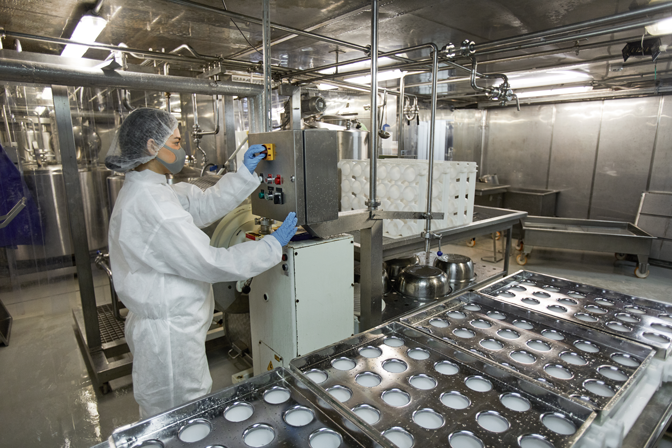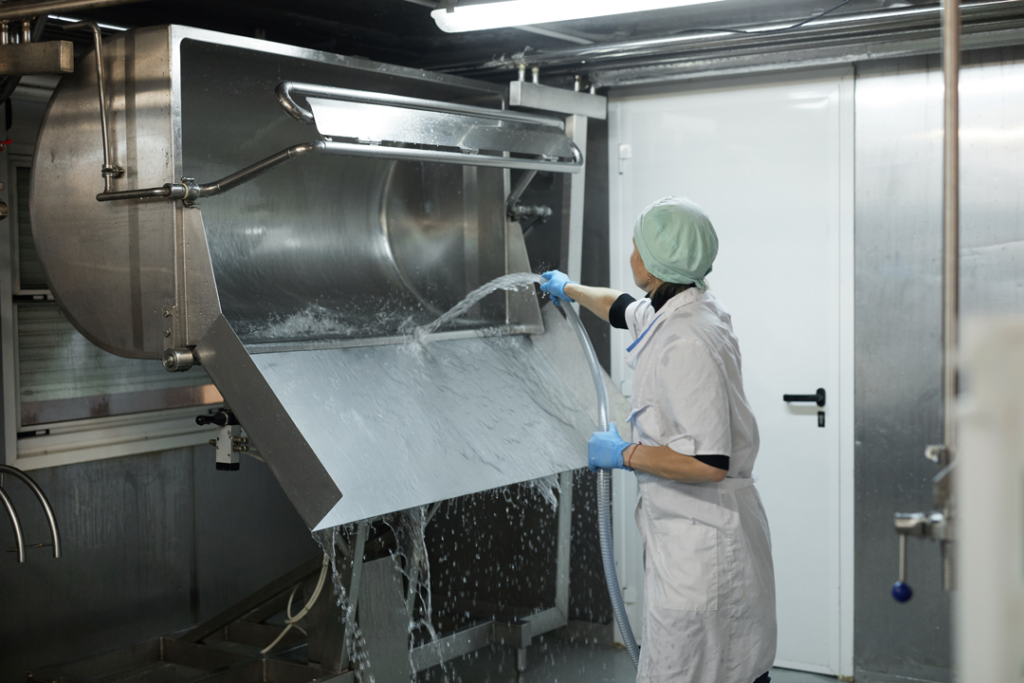You’ve finally decided to commercialize your famous secret salsa that everyone loves at family gatherings and the neighborhood Super Bowl party. The local co-op has even shown interest in selling it in their stores. But before they will do business with you, they want you to pass a GMP food audit or obtain a food safety certification.
After some research, you’re quickly drowning in a sea of confusing acronyms: GFSI. SQF. BRCGS. FSSC. GMP.

Given that your company is just starting out, you don’t have the money or personnel to obtain a comprehensive GFSI-benchmarked food safety certification. And, for some companies, a GFSI certification is more than they need.
In your case, a Good Manufacturing Practices (GMP) food audit may be the perfect solution.
A GMP Food Audit is Much Easier to Pass
Compared to a GFSI-benchmarked certification, a GMP audit is…
- Much easier to pass
- Less expensive
- Less time-consuming, typically taking only one day to conduct
Passing a GMP audit in the food industry shows your potential customers that you have a basic food safety system in place and provides a level of trust in your products.
In this article, we explain everything a food manufacturer needs to know about undertaking a GMP food audit. Plus, we provide a free GMP checklist for food industry. It includes everything you need to know to prepare for a GMP audit as a food manufacturer.

What is a GMP Audit?
A GMP audit is a third-party inspection of a manufacturing facility to verify that its people, processes, and products comply with current Good Manufacturing Practices (cGMPs).
This helps ensure that the manufacturer is producing food and other products that are safe for humans to consume or use.
Passing a GMP food audit tells your customers that you follow safe practices regarding food production and that they can trust the integrity of your processes and products.
What are GMPs?
The U.S. Food and Drug Administration has established current Good Manufacturing Practices (cGMPs) in 21 CFR Part 117 to help ensure the safety of food. The FDA has also published additional GMPs for certain types of food, including the following:
- Dietary supplements (21 CFR Part 111)
- Infant formula (21 CFR Part 106)
- Low-acid canned foods (21 CFR Part 113)
- Acidified foods (21 CFR Part 114)
- Bottled water (21 CFR Part 129)
The USDA also publishes its Good Manufacturing Practices (GMP) Audit Standard, which outlines GMPs for USDA-regulated products, such as meat, poultry, and eggs.
GMPs are guidelines that set the minimum requirements for safe production of food and other products to reduce risk. They encompass all aspects of the business, including…
- Raw materials
- Production
- Sanitation
- Recordkeeping
- Employee training
- More
GMPs in the food industry help ensure a safe food supply and reduce instances of foodborne illnesses.
GMPs in the Food Industry
To that end, GMPs in the food industry are designed to be rigorous and comprehensive. If you’re new to GMPs, all the regulatory language can be intimidating.
It’s important to remember that many of the regulations are common sense rules that help keep everyone safe. Plus, our Certification & Audit Specialists are always happy to walk people through the GMP food audit process and answer your questions. (Our GMP checklist for the food industry also helps you know what to expect.)
Since this article focuses on GMPs in the food industry, let’s look at some of the key regulations in 21 CFR Part 117 and 9 CFR. This will help you understand what to expect.

1) GMP Audit Requirements: Personnel
Plant management must take reasonable measures to ensure the following:
- Any person who has an illness or source of abnormal microbial contamination, such as an infected wound or sore, shall be excluded from operations.
- Everyone working in direct contact with food or food-contact surfaces must follow hygienic practices, including (not limited to) the following:
- Wearing suitable outer garments for protecting against contamination.
- Maintaining personal cleanliness.
- Washing hands thoroughly.
- Wearing proper gloves, hair nets, beard covers, and other equipment that guards against contamination.
- Personnel should have the proper training to identify sanitation failures or food contamination.

2) Plants & Grounds
GMPs for food safety require the grounds around the food manufacturing plant to be kept in a condition that will protect against contamination. This includes not only the maintenance practices that govern the plant, but the construction and design of the property.
- Store equipment properly, remove litter and waste, and trim grass/weeds that can harbor pests.
- Maintain roads, lots, and yards in a manner that reduces potential contamination.
- Drain areas that may contribute to contamination or allow pests to breed.
- Operate waste-disposal systems in a fashion that reduces contamination.
- Provide sufficient space for equipment and storage.
- Design the plant in a manner that separates potential contamination areas with sufficient space or mechanical means, such as by ventilation or partition.
- Construct the plant in such a way as to permit the adequate cleaning and condition of floors, walls, ceilings, and other surfaces.
- Provide adequate lighting and ventilation.
3) Sanitary Operations
GMPs in the food industry include several regulations that ensure operations are conducted in a sanitary fashion. Not only must operators keep the plant properly maintained and cleaned, equipment and utensils used to manufacture food, contact surfaces, and packaging must all be clean and sanitary.
- Cleaning compounds and sanitizing agents must be free of undesirable microorganisms.
- Toxic cleaning compounds must be identified and stored in a manner that protects against food contamination.
- Pest-control measures must be in place to prevent any pests from contaminating food.
- Food-contact surfaces must be cleaned as needed to prevent contamination.
- Cleaned and sanitized portable equipment must be properly stored.

4) Sanitary Facilities & Controls
The manufacturing facility must have adequate sanitary facilities that include the following:
- Safe, sanitary water supply of the adequate temperature and pressure for food processing.
- Plumbing system designed to provide adequate water supply, properly dispose of sewage and liquid waste, avoid constituting a source of contamination, provide proper floor drainage where needed, and prevent backflow.
- Proper sewage disposal system.
- Toilet facilities for personnel.
- Hand-washing facilities.
- A system to properly dispose of trash and offal that minimizes odor and the potential for waste to become a source of contamination or pest harborage.
5) Equipment & Utensils
A facility could use several pieces of equipment or utensils to manufacture food, such as mixers, conveyors, freezers, and more. GMPs for the food industry include regulations that specify how this equipment must be maintained and cleaned, such as those listed here.
- All equipment and utensils must be cleanable and properly maintained to prevent allergen cross-contact.
- Equipment must be designed and used in a way that minimizes contamination of food with water, lubricants, metal fragments, or other contaminants.
- Food-contact surfaces must be resistant to corrosion.
- Seams on food-contact surfaces must be bonded to minimize accumulation of food particles.
- Each freezer or cold-storage device must be equipped with a thermometer to accurately show the temperature within the compartment.
- Instruments and controls for measuring variables such as pH, moisture, temperature, and acidity must be adequately maintained and precise.
6) Production & Process Controls
Process control encompasses several activities throughout a food manufacturing plant, so you can imagine that there are several regulations to consider. Many of them overlap with and build upon some already listed. Highlights include the following:
- All operations in the manufacturing, processing, packaging, and holding of food must be done in accordance with adequate sanitation principles.
- You must use appropriate quality control measures to ensure your food product is safe for human consumption.
- Overall plant sanitation must be assigned to one or more competent individuals.
- Raw materials must be handled and stored in a manner that minimizes the potential for allergen cross-contact, deterioration, and contamination.
- Raw materials cannot contain levels of microorganisms injurious to human health.
- All food manufacturing, processing, packaging, and holding must be done under conditions that minimize the potential for the growth of microorganisms, allergen cross-contact, contamination, or deterioration.
- You must take effective measures to prevent finished food from being contaminated by raw materials, allergens, refuse, or other ingredients.
- Adulterated food, raw materials, or other ingredients must be disposed of in a manner that prevents contamination of other food; if it is reconditioned, it must be done so according to proven methods.
GMPs for the food industry also include regulations for warehousing and distribution, the holding and distribution of human food by-products for use as animal food, and defect action levels.
The 5 P’s of a GMP Audit

What Does a GMP Food Audit Include?
A GMP audit will focus on the five Ps:
- People – Workers must be properly trained for their job function and wear the appropriate protective equipment (hair net, gloves, beard cover, etc.) to protect against contamination. They should also have access to hand-washing facilities, restrooms, and break areas away from production.
- Premises – Your facility must follow adequate sanitation practices and maintenance principles inside and out. The GMP auditor will not want to see weeds and vegetation growing out of control adjacent to doors or windows. The interior should be clean, maintained, well-lit, and ventilated. Equipment should be clean and well maintained.
- Processes – Write specifications, work instructions, and procedures that ensure production of safe and legal products. Have these instructions available to workers to ensure compliance to HACCP and/or food safety management systems.
- Products – Your products should be properly labelled according to regulations, consistently manufactured, handled and stored properly and, above all, safe for human consumption.
- Procedures – Again, Standard Operating Procedures are a must when manufacturing food products. Write down clearly what you are going to do, and then do it according to your SOPs. Keep adequate records of changes to your SOPs, customer complaints, batch codes, laboratory testing results, and other pertinent information.
Basic Steps of a GMP Audit
Any audit can be daunting, especially when your business is at stake. It helps to understand the basic steps of the food audit so you can prepare.
One of the benefits of a GMP audit is that it typically takes only one day, whereas food audits to obtain a GFSI-benchmarked food safety certification, such as BRCGS, SQF, or FSSC 22000, can take multiple days.
- Opening Meeting – The GMP auditor will hold an opening meeting with your team to document who is present and walk through the steps of the audit with you.
- Document Review – The auditor will often review written documentation that helps demonstrate if your company is following Good Manufacturing Practices, such as Standard Operating Procedures, batch records, and even your company mission statement.
- Facility Audit – The GMP auditor will walk around and observe your facility, personnel, production process, and other procedures. They may interview key personnel, directly observe your manufacturing process in action, and ask questions, so be sure to have the appropriate personnel on hand as they make their observations.
- Closing Meeting – Following the audit, the auditor will hold a closing meeting where they may provide some high-level feedback about your operations. This is often a chance to find out if there are any violations and prepare to resolve them.
- Final Report – The auditor will complete a written report within a few days that documents their findings and indicates whether you pass or fail.
Tips for a Successful GMP Food Audit
- Be Prepared – It may sound obvious, but companies can fail a GMP audit simply because they were not adequately prepared. Ensure your team is aware of the audit and understands FDA and USDA Good Manufacturing Practices regulations.
- Stock Your Meeting Room – Set aside a meeting room or conference area where the audit meetings can take place. Have all the required documents available for the auditor, including the following:
- Organizational chart
- Plant layout
- Training documentation
- Quality Systems Manual
- Standard Operating Procedures (SOPs)
- Ensure Electronics are Working – If accessing digital documents, ensure the computer system is operational and ready to go to prevent awkwardly searching for documents while the auditor waits.
- Have the Right Personnel Available – Part of passing a GMP audit is demonstrating that your company leadership supports your quality program and buys into the message. Have the right people available for the audit, including key leadership. Block off their calendars so they can focus on the audit. Designate someone to be your team’s lead when communicating with the auditor.
- Complete a Pre-Audit Checklist – Review a GMP in the food industry checklist of what the auditor will be looking for during the audit. Review it with your team beforehand so you have time to adequately prepare. Conducting a pre-audit with a registered Certification Body, such as FSNS Certification & Audit, is another great way to help prepare.
Prepare with a GMP Audit Checklist
One of the best ways to prepare to pass your audit is to review our GMP audit checklist for food manufacturers with your team. Use it to know what the auditor will be looking for before the audit begins.

What is GMP Certification?
Although people often ask about it, there is no such thing as “GMP Certification”. This is a common misperception in the food safety world.
Adhering to GMPs is required to obtain common product or management system certifications, such as SQF, BRCGS, and FSSC 22000. In other words, you must demonstrate to the auditor that your facility complies with GMPs as part of an SQF, BRCGS, or FSSC 22000 audit.
However, “GMP Certification” is not a standalone accomplishment that can be earned by itself.
So, why have a GMP audit at all?
Because, as mentioned earlier, many retailers require you to pass some kind of third-party food safety audit before they will do business with you, and a GMP audit is much easier to pass, takes less time, and is more appropriate for many companies, such as smaller start ups or “mom and pop” companies.
A GMP audit is also a great entry into the world of food safety certification if your company wants to eventually earn a GFSI-benchmarked food safety certification.
Why Choose FSNS C&A for Your GMP Audit?
We love working with smaller companies and organizations that are new to food safety audits and certification. We answer the phone when you call and work with you to understand your goals to recommend the best course of action for your company.
- Each of our auditors has an average of 14 years of experience working in food manufacturing.
- 99% auditor satisfaction rate.
- 99% satisfied with our client communication.
- ISO 17021 and 17065 accredited.



![Top 10 Reasons for a BRC Audit Non-Conformity [2025]](https://fsns.com/wp-content/uploads/2022/08/shutterstock_1033058215-1-400x250.jpg)
![Top 10 Reasons for an SQF Audit Non-Conformity [2025]](https://fsns.com/wp-content/uploads/2023/06/shutterstock_792336616-scaled-1-400x250.jpg)